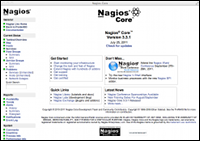Nagios version upgrade to 3.3.1
On Monday July 25th 2011, Nagios version 3.3.1 has been released. The latest release is introducing a fresh new web GUI styling along with a few bugfixes, overall the amount of changes is small. The new look is pleasant and more presentable, it is time to upgrade again. How to do it safely and with minimal impact is topic of this how-to ...
[start introduction]
[part-1 preparations]
[part-2 test and customizing]
[part-3 production cutover]
2011 Tokyo environmental radiation monitoring
On March 11, 2011 at 2:46pm (JST), a 9.0-magnitude earthquake struck the north-east coast of Japan, triggering a massive tsunami killing thousands and leaving hundred thousands without a home. In its wake developed a unprecedented crisis at the Fukushima nuclear power plant not far from Tokyo. We are trying to come up with ways of emergency response and radiation monitoring to protect health and lives... [read article]
Security patch monitoring
For several years now we are struggling to patch our IT systems timely to remedy bugs and close security holes. Automating the watch for new online OS patch updates is extremly helpful, especially when it is integrated into a existing monitoring and notification tool like Nagios. It eliminates the need to explicitly check each systems patch level and helps IT Security to evaluate the risk level across different OS platforms and support groups.
For an overview , here is the Security Patch Monitoring with Nagios - 2009 OSMC Presentation [get PDF]
- SUSE Linux SLES10 Nagios SNMP patch update monitoring [read article]
- OpenSuse 10.3 Nagios SNMP patch update monitoring [read article]
- Cisco IOS version compliance monitoring with Nagios [read article]
- Windows systems patch update monitoring with Nagios [read article]
- IBM AIX systems patch update monitoring with Nagios [read article]
Operating system monitoring
Setting up basic OS monitoring with Nagios is straighforward: either deploy a monitoring agent or use SNMP if it is available. However, each OS has it's own way of workings, and the modification into 'appliances' de-standardize our monitoring even more. Below are articles for dealing with systems 'specifics' in order to bring them into our centralized monitoring system.
- Configuring SNMP on IBM AIX systems for use with Nagios [read article]
- Monitoring Windows Reboots through SNMP traps with Nagios [read article]
- Device auto-discovery and printer monitoring with Nagios [read article]
- Monitoring Avaya Media Server load with Nagios [read article]
- Monitoring custom application log files under Windows [read article]
Database monitoring
Many modern business software applications use a Relational Database Management System (RDBMS) as their backend data store. With these databases and their stored data being at the "heart" of applications, database "health" is critical to IT. This article describes how to monitor the Big-4: Oracle, IBM DB2, Microsoft's SQL-Server and MySQL databases with Nagios [read article]
Web monitoring
The "web" became the de-facto way of deploying the enduser interface to applications and it is still growing. Monitoring websites became critical to ensure application access is possible and within acceptable time limits. Belows articles deal with specific issues of 'web' monitoring.
- Monitoring SSL-Websites through Proxies using CONNECT [read article]
- Monitoring Apache session load with Nagios through mod_status [read article]
Flexible Nagios Notifications
One of the core functions in a availability monitoring system is the ability to send out status alerts and notifications. However, Nagios only comes with a a set of 2 default notifications through e-mails. These provided notifications are minimalistic and barebone, not sufficient for todays requirements of sending taylored notifications in either text or HTML format, including or excluding additional information and supporting multiple languages. This article describes a Nagios notification implementation that solves many shortcomings, [read article]


